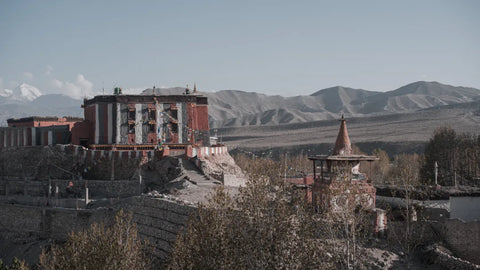A resident of Mustong wearing sunglasses
Local residents waiting for support.
Residents living in TeTang Mud Fortress
The locals carrying buckets to water the stained pagoda.
Local people who wash pots.
Monk in the temple taking a break and chatting casually.
Local people in the 14th-century Buddhist temple serving tea to the practitioners.
The original villages along the Mos Tang region connect countless ancestors who traveled between India and Tibet for centuries. In the 8th century, Padmasambhava entered Tibet through this area. In the 11th century, Atisha Dipankara traveled from here to the ancient kingdom of Guge. Milarepa also continuously journeyed through this region.
Early period statue of Master Lian, Gahoe Temple, clay sculpture
The pagoda on the way to the border of Zamba County.
Kagbeni——Gateways along the ancient salt transport route
Devthen chhorten
The tower gate entering the city
Kagbeni is a very unique medieval village in the Lower Mustang region. Located on the popular Annapurna Circuit Trekking route, it serves as the gateway to Upper Mustang.
The village still preserves ancient fortresses that were built along the early trade routes, with mud-brick houses, dark alleys, and unique chortens. The local residents still live in these ancient dwellings to this day.
Gate of Kagbeni (Glutton)
For a long time, Kagbeni has been the gateway to trade routes leading to various destinations. The four ancient trade routes that passed through Kagbeni are: Upper Mustang in the north, Dhorpatan in the west, Manang in the east, and the mountains of Nepal in the south.
Kagbeni still retains its fortress town characteristics and has a deep cultural heritage. The town played a very important role during the prosperous "salt trade" era between Tibet and Nepal.
Tangbei Village——Picturesque village

The Tangbetani people are described as the indigenous people of Nepal, residing in the Balhagoon area of Mustang. Their appearance is similar to the Loba people, and the area is heavily influenced by Tibetan culture. However, with most of the villagers moving to the more comfortable Pokhara to live, the village has become deserted, with walls painted in three different colors, giving it a picturesque feel reminiscent of scenes in the book "Along the Himalayas".
The residents here have their own unique language called "Serke", meaning golden language. They have their own distinctive clothing and ornaments. They also have traditional cultural songs that they sing during festivals, dancing along to the melodies of the songs.

Chuksang——Neglected cultural treasure trove
Chuksang Village
Residents repairing the Buddhist pagoda.
Chuksang Village is a transit station that must be passed through by both hikers and jeep travelers heading to the Rongbuk Monastery. Here, there is a trail leading east to Muitinath and even further to the Mustang region, and most travelers choose to have lunch here. The deep cultural heritage surrounding the village is often overlooked as travelers are drawn to the colorful cliff caves in the distance.
Travelers pass by in a hurry, with very few people exploring the surrounding areas. Just a short distance from the village, there are two ancient temples, one of which is located just above the check point, dating back to the 11th and 12th centuries.
the Buddha Shakyamuni
11th-12th century cave temples
This Buddhist temple may have been built around the 11th or 12th century, and the influence of the ancient Guge Kingdom, which was prevalent in the Three Regions of Ali, can also be seen here. According to local legends, the creator of the Guge Kingdom, the great translator Rinchen Sangpo, also visited Mushtang to spread his teachings, although specific records are difficult to find. Clearly, the Guge influence had a significant impact on the sculptures and practices of the 11th-12th century in this area.
Tetang Village —— Ancient castle built with mud bricks

The mud fortress of Tetang near Chuksang Village.
In the heart of the mud fortress village, hidden away from the main road, the village appears even more primitive compared to the surrounding settlements. Local residents leisurely play traditional dice games in the village, chatting about their daily lives in the narrow alleys. The village is divided in half by a massive cliff river, and the winding village roads often lead to getting lost.
Villagers taking a break.
A child climbing up a wooden ladder.
The complexity of the Mud Fortress once showcased its past glory. The ancient temples at the Mud Fortress have been preserved, but are now desolate, with only a few old relics and faded murals remaining. Hundreds of years old scripture boards reveal that Buddhism once flourished here. Most of the gate ruins can also be seen in Mustang, but they have long been in ruins, with the contents inside lost to time.
The residents of Jiling Village are chanting ancient prayers towards the distant sacred mountain.
The pagoda in the temple grounds and the snowy mountains in the distance.
Jiling Village is a relatively large village in the surrounding area, with mountain spring water flowing down from the mountains. Not only are there large pagoda relics in the village, but also a 15th-century temple on the mountainside that leaves a lasting impression. Many hikers also choose to live here.
Chungsicave —— Padmasambhava's place of practice

Statues and murals of Padmasambhava inside the cave where he practiced meditation.
This place had been a gathering place for many practitioners long before the renowned master Lianchi departed for Tubo. It is also a place where the Hindu deity Shiva passed through on his way to Mount Kailash for pilgrimage.
I first heard of this place because of an elderly Nyingma practitioner who told me one day that he was going to retreat in a cave in Mustang.
Padmasambhava reveals his true form
Located in a very precarious mountain valley, surrounded by steep cliffs, this place is a "self-generated" cave. It is not artificially excavated and is considered a sacred site by the Himalayan residents. The cave is full of natural wonders.
Ghemi —— Enter the beginning of Lianshi's demon-slaying.
Ghemi is an important stop along the trekking route, and the village here left me with the impression of being a place where there are some lodges and local residences, surrounded by trees and fields. In the center of the village there is a stone wall with mani stones, and a stupa with the characteristic Nepali Buddhist eyes, inside which there are exquisite ceiling paintings.
The village is located along a river, with clean and clear water. There are rarely any monks present in the monastery within the village, but it still retains some century-old restored wall paintings and early clay sculptures. When the monks are away, they will entrust the key to nearby villagers.
A 300-meter-long wall of mani stones.
Outside of Ghemi Village is the longest Mani wall in the Upper Mustang region, standing at 305 meters high. Beyond the Mani wall, a cluster of picturesque large stupas and jagged cliffs seamlessly blend in, creating a stunning landscape.
Legend has it that this area is also associated with Padmasambhava subduing demons, where he buried the demon's intestines here and colored the Mani stones on the wall. This is an important sacred site for pilgrims along the Upper Mustang trek.
Pagoda in the Wilderness
Dhakmar —— The land stained red with the blood of demons.
Village with its back against a red cliff.
There is a village path from Ghemi Village that leads to Dhakmar Village, but this road will bypass the opportunity to see the 300-meter-long Mani stone wall up close, and can only be viewed from afar at the mountainside. From the bend at the mountainside, you can see a red valley in the distance. Legend has it that the red color here is due to the blood of demons spilled on the cliffs.
Locals use local clay to embellish the prayer walls in the village.
Dhakmar Village in the Oasis
Outside the ghar temple is the local pasture.
Ghar Gompa is the oldest monastery in Upper Mustang, dating back to the 8th century. It is said that this ancient monastery has a close connection with the Sangey Monastery in Tibet.
Ghar Gompa, also known as Lo Gyaker, is the oldest temple in the Mustang region, founded by the Great Master Padmasambhava in the 8th century as a Nyingma monastery. Legend has it that when the Sangey Monastery in Tibet was being constructed, it was repeatedly destroyed by demons, prompting Padmasambhava to vanquish the demons.
Early murals and Buddha statues left in the Buddha Temple
The location of Ghar Temple is believed to be the very place where the heart of the demon was discarded, and according to a legend, a temple had to be built here first before Sangye Monastery could be constructed. Therefore, many people believe that this temple predates Sangye Monastery.

The locals are repairing the temple.
Tsarang ——The ancient capital of the Kingdom of Luo.

Tsarang is the second largest settlement in Upper Mustang, second only to the capital Lo Manthang. It is also the former capital of the Kingdom of Lo, where the old royal palace still stands, preserving statues of Guanyin from around the 7th century, as well as armor from the royal dynasty period, bones and utensils used for worship, and other ancient artifacts.
From the top of the palace, one can overlook the entire Tsarang. The most prominent structure is a monastery built in the 16th century, with a unique Sakya sect three-color exterior wall style, and in front of the monastery lies the remains of an ancient stupa.

Pagoda in the village
In the temple, a complete set of prayer beads are still preserved, along with ancient scriptures carved on wooden boards indicating the presence of ancient Tibetan scriptures. The surrounding area also boasts a wealth of early wall paintings and exquisite statue art within the Buddhist niches.
Kushu is reciting scriptures.
Lo Manthang —— Save the most complete Tibetan medieval castle.
 Lo Manthang city wall
Lo Manthang city wall
At an altitude of 3810 meters, Romantown is surrounded by deep river valleys, with the city located in the middle of a huge plain. The city wall is about 7 meters high, with a circumference of about 750 meters, and has an overall L-shaped layout, with entrances and exits at both ends that must descend to the river valley before rising up on a huge curve.
Romantown was founded in 1441 AD, and the main buildings in the city include a white palace and several red temples, as well as lower residential houses. Currently, there are about 150 houses in the ancient city, housing thousands of people. The residents in the capital still maintain traditional ways of life, with cattle and sheep returning home in the evening, and each house stacked with firewood for winter heating.

The mural of Shakyamuni Buddha in Thubchen Gompa Monastery.
Lo Manthang has three ancient temples, including the Buddhist college Chodey Gompa established in the 17th century. The main hall still preserves wall paintings with a style distinct from other temples, closely resembling the architecture of the Amdo region. The monks of the temple live and study here, and in recent years, the museum of the temple, which used to be open to the public, has been converted into classrooms due to the epidemic.
Jampa Gompa is located on the second floor of the early Buddhist temple, as most of the other areas of the building have been damaged. The second floor is a secret Mandala hall, decorated with various Mandala sculptures, each detail showcasing the skillful brushstrokes of the artist.

The mural of the Vairocana in the altar of Jampa Gompa.
The three temples in the 1990s were already in ruins, and from the 90s until now, they have been undergoing repairs. Currently, the restoration is nearing completion, and the narrative depictions below the main Buddha hall have completely disappeared. The master restorers of the murals drew inspiration from the materials of the murals in the corridors of Xialu Temple, shrinking them and rearranging them here. The main Buddha statue has been completely restored, showing the transition from old to new and fully restoring the original layout of the murals.
Vaishravana Wall Painting in Chodey Gompa in the 17th century
Lo Manthang Palace is a nine-sided, five-storey building built around 1400. Currently undergoing maintenance and not open to the public, it is considered by scholars to be one of the best-preserved medieval castles.
I enjoy taking evening strolls in the narrow alleys of Romantang, even during the peak tourist season when local residents lazily go about their business. Many doors are tightly shut, and tourists have already retreated to their hotels, enjoying the solar-heated water that has not been used by other guests.
The play of light and shadow in the city is quickly obscured by the towering city walls, with the faint glow of the pagoda in the city center.
The children of Lo Manthang
The descendants of Ame Pal ruled as kings of the Lo dynasty for 25 generations until it was annexed by Nepal in 2008, effectively abolishing the monarchy of the Lo dynasty.
The last Lo king, Jigme Dorje Palbar Bista, passed away in 2016. He was highly revered and respected by the local people, and his photos with the queen can still be seen in various villages and towns.
The gate of the Lo Manthang City
At the gates of the Lo Manthang Castle in the evening, locals are herding cattle and sheep back to the city, sitting at the gate chatting and resting. A splash of red often appears, adding a unique touch of color to the quaint scene.
It feels like going back to early Tibet here, as this well-preserved medieval castle speaks to visitors about the stories that have taken place over the centuries.
A-Jia who leads the calf home
Chhoser —— Thousands of years old cave complex

nyphu gompa
Rock-cut temple
Before coming here, I was even fuzzy about the name, and I couldn't even find the place on the map. Although there are many one-day tour routes in Roman Tong, but in fact, it takes more than an hour to walk from here to Roman Tong. For those who have already walked to Roman Tong, this distance is like taking a stroll.
Early practice cave remains, filled with early wall paintings.
Along the way, we passed by traditional villages and abandoned pagoda ruins. It wasn't until we reached Chhoser that we realized it wasn't just a cave, but there were countless caves surrounding it.
Jhong Cave is the most famous, but it doesn't contain any preserved murals. The winding caves reach up to five levels, and according to some archaeologists' speculations, it is possible that a tribe lived here three to four thousand years ago, using the caves as their homes, a tradition which has been maintained until today.
Around the 13th century
Wall paintings of Gautama Buddha inside caves
And scenes of the life of monks at that time
Even in many caves, human remains from 1000-2000 years ago can be found, suggesting that the burial practices dominated by the Benzhu culture were popular at that time.
Another cave 13th century
Mural of the Eighty-Four Achievers
The history of Mustang dates back much further than the 15th century during the Lho dynasty. It can be traced back to a long time, preserving a vast amount of historical relics that witness the changes of time, cultural exchanges, and the spread of Buddhism.
The cave here is occupied by local herdsmen.
Unprotected murals
have been blackened by the herdsmen's cooking fires.












































 Lo Manthang city wall
Lo Manthang city wall













